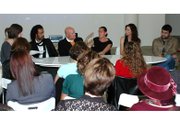FGI Discusses L.A.'s Strengths
Los Angeles fashion and the city’s strengths were the topics of conversation when Fashion GroupInternational–Los Angeles hosted its biannual trend forecast and panel discussion.
The Nov. 19 event, held at the Cooper Design Space, was moderated by California Apparel News Fashion Editor N. Jayne Seward, who put together the panel, which featured designer Juan Carlos Obando; Cristina Ehrlich, celebrity stylist and co-founder of the Miss Davenporte line; Mark Werts, founder and chief executive officer of American Rag and the World Denim Bar; Henri Meyers, director of public relations, special events and image consulting for eM Productions; and Betsee Isenberg, co-owner of The Bank and Hatch showrooms and owner ofthe 1011 and Theory showrooms in Los Angeles.
“One of the strengths of L.A. is that we take something that is casual and make it fashion,” Isenberg said. “We are eclectic. It’s not so serious. It’s not so ’suit-ified.’ There are no rules. It is not dictated. It’s a lifestyle.”
Meyers agreed, calling the city “the last frontier.” Em Productions’ clients include local up-and-coming designers, as well as a growing number of international labels looking to tap into Los Angeles’ celebrity trendsetters. “There’s a lot of freshness here, and people want a piece of that,” Meyers said.
Obando found the resources for producing his 3-year-old designer collection among the local design community. “The people that have supported me and given me advice have all been in L.A.,” he said. “My work has been done here. The materials I use are from France, but [representatives from French textile mill] Solstiss/Bucol are in L.A.”
Areas of expertise
Many on the panel counted the rise of the premium-denim category among the city’s success stories.
But Werts noted that Los Angeles was setting trends long before denim became a wardrobe staple.
“In the golden era of Hollywood, L.A. influenced the world because we produced the films,” he said. “It’s not an accident that we’re the denim capital of the world because we’re so far ahead.”
World Denim Bar carries 73 different denim brands. Among the recent top sellers were RRL, J Brand and Levi’s.
“It’s like the Kentucky Derby of denim,” he said. “The winner gets to supply more product and they get more square footage.”
Ehrlich and her design and styling partner, Estee Stanley, count several A-list celebrities among their “girls.” During the evening, Ehrlich referenced several actresses by first name only: Jessica (Biel), Ashley (Olsen) and Penelope (Cruz).
“We help our girls create a style that is realistic for them,” Ehrlich said. “It’s all about being classic and timeless. So they can look back at Wireimage and not say, ’What was I thinking?’ They’re not [on the red carpet] to sell the dress. They’re there to promote their movie.”
But Ehrlich stressed that her clients are not simply looking to her and Stanley for red-carpet looks.
“Denim is such a huge part of what we do,” Ehrlich said. “Every woman aged 12 to 75 wants to find the right fit. It always comes back to girls always want the best jean for them.”
Timing is everything
Among the more-controversial issues raised at the otherwise-upbeat event was the timing of Los Angeles market weeks and many local designers’ decision to break their lines in New York.
Obando held a small presentation for his Spring 2007 line in New York in September 2006, before returning to Los Angeles to show his Fall 2007 collection.
“I wanted to go to New York to test—to show some buyers what I do. I truly believe in research,” he said. “But even if it’s the right time, you don’t only have to have the talent, you have to have the right supporters. Everything has to be in alignment.”
For Isenberg, the issue isn’t Los Angeles’ reputation as a fashion center, it’s the late timing of its fashion markets.
“People look to California for great product. California designers are seen as novel and interesting,” she said. “[Buyers] are looking for L.A. designers. They just don’t want to wait to find them in L.A.”
Many West Coast designers opt to break their lines at New York trade shows such as Fashion Coterie and Designers and Agents because these events fall earlier on the calendar, when buyers have more money to spend.
“We tend to show late,” Isenberg said. “It’s eight weeks after New York [market] and four weeks after Paris. People are done looking at fashion. People are done buying. From a sales perspective, if you wait for L.A. [market], you’re not going to be in business.”
But Werts countered by saying his buyers are constantly on the lookout for new product.
“We want American Rag to be new every single month,” he said. “I’m not tied to a calendar because we have budget to buy every month. We want a flow of new product 12 months a year.” —Alison A. Nieder






















